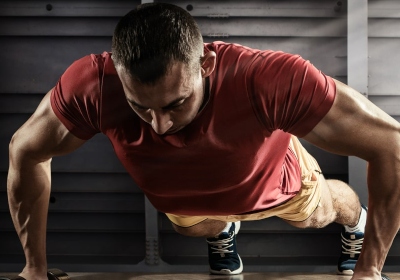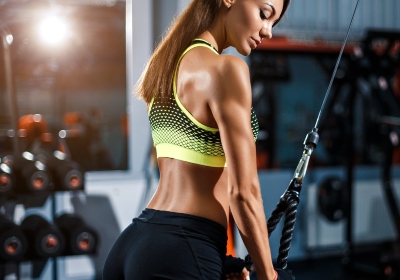VIDEO
Dumbbell Wrist Extension
- Wrists
- Triceps
Level:Intermediate
Trainer:Nick Taylor
Equipment:Dumbbell
Grab the dumbbells in each hand and load them over your head. Stand with your feet shoulder-width apart. And from this position slowly and smoothly twirl your wrists inside and outside. This exercise is going to target your forearms.
save to ...
RECOMMENDED FOR YOU
ARTICLES
Push-ups, strength exercises, gymnastic elements on rings and a horizontal bar, handstand - all these exercises require strong and flexible wrists. Let’s discuss how to develop your wrist strength and do exercises without pain and discomfort.
The wrist is a movable connection of the bones of the forearm and hand of a person. It is formed by the extended and concave carpal articular surface of the radius and a medially located triangular cartilaginous disc, representing a concave articular surface articulating with the convex proximal (located closer to the body) articular surface of the bones of the first row of the wrist: scaphoid, lunate and trihedral.
The proximal row is connected with the exchange cyst behind the additional exchange wrist joint. The skin row is set in an arch, bent proximally and distally bent. On the long sides of the wrists of the vignutia set up the carpal canal, we will fix the flexor retinaculum. The proximal row is connected with the surfaces of the exchange brush and the distal row. In the proximal row, the dermal cyst can be surrounded by an undisclosed ruffle: for example, it is more like the fate of the unprotected midget steel, which can be easily joined from the trapezoidal and trapezoidal style. The cysts of the distal row, on the other hand, are more rigidly fastened, so that the whole row collapses at once with the pastoral cysts.
Some sports require strong wrists. Wrist strength should be developed in parallel with flexibility. This will help you do exercises that require not only good grip but also joint mobility. Exercises for the wrists are also useful for people who are far from sports. Warming up and stretching the wrists can help avoid tunnel syndrome - the compression of the median nerve between the bones and tendons of the wrist. Warming up will help relieve tension and will be excellent pain prevention.
The number of eight wrist cysts can be divided into two transverse rows (proximal and distal), or into three later colonies.
Training
Bear Crawl Lunge. Move forward by moving the right hand and the left leg with a crawling movement. Just after placing weight on the right hand and left leg, turn the sides and move the left hand and right leg forward. Keep the body pretty low and continue with crawling movements. Imagine that you are crawling beneath a low net.
Half Handstand Variation. Begin with the downward-facing dog position. Walk your feet in closer to your hands. Keep your left foot on the ground, lifting onto the ball, and begin bending the knee. Lift the right leg and straighten it behind you. After taking a few hops, jump off the bent leg and lift the straight leg toward vertical. Keep flexing your lifted foot for engagement. Now, try to bring both heels to the wall. Keep breathing deeply while your head is down between your upper arms. Remember to engage your legs and reach up through your heels. Walk your legs down the wall. Then get back to the starting position with your feet on the ground. Make a deep squat and jump out.
Inchworm Variation. Put your hands on the ground and your feet - on the elevated surface (a bench). Start walking your hands out, as far as you can keeping your legs straight throughout the movement. Make a pause. Walk your hands back up to the starting position.
Read more
The muscle on the back of your shoulder is called the triceps. Triceps originate from the scapula and humerus and attach to the ulna using the triceps tendon. The triceps muscle does the function of extension in the elbow and acts as an auxiliary in the implementation of other movements in the shoulder. During triceps contraction, the vector of movement is transmitted using the tendon.
The mass fraction of the triceps is approximately 2/3 of the muscles of the shoulder, so its size plays a critical role in the formation of beautiful arms. By focusing on the biceps, and forgetting about the triceps muscle, athletes contribute to getting inharmoniously developed arms.
You shouldn't train your triceps more often than 1-2 times a week. Do not forget that many exercises for the pectoral muscles load the triceps, so make up the training program so that the triceps and pectoral muscles are trained on different and distant days, thus some periodization of the load is achieved.
But in some cases, the triceps can be trained on the same day as the pectorals, since all basic chest exercises involve the triceps and vice versa. This means that if you swing your chest, then the triceps already swing by themselves. To increase efficiency, do triceps workouts of different intensities: light-medium-hard, and so on. Rest for at least 1 week after a hard workout.
In classic splits, the triceps are usually the most overloaded muscle, due to the very specifics of training in split programs. To increase the volume of the triceps muscle, do 8-15 repetitions. The total number of triceps sets (the sum of the sets of all triceps exercises) is 3-6.
The basic exercises for pumping triceps are reverse push-ups on the bench and narrow grip barbell press. In addition, an important exercise is a pull of the upper block with a rope - one of the few that uses the lateral head in the work. Since the mechanics of movements are in many ways similar, it is recommended not to combine the presented exercises, but to alternate.
Training.
Reverse push-ups from the bench. Starting position - heels touch the floor, hands on the bench behind your back. Slowly lower your torso down, linger at the bottom point, then with an explosive force push your body weight up over the bench. The elbows are directed backward. To complicate things, use an extra load by putting the weight on your hips.
Bench press with a narrow grip. It’s the exercise to work out the medial head of the triceps. Lie on a bench (keeping your feet firmly on the floor), grab a barbell or dumbbell with a narrow grip, then lift the weight up. During execution, the elbows should be pressed as close to the body as possible.
Bent over triceps extension. It’s for pumping the long and lateral heads of the triceps. When pulling the arm back, make sure that the elbow does not change position (that is, do not swing the arm back and forth or left and right). Also, watch out for the arch of the back - to do this, keep the abs slightly tense.
Top pulldown with rope. A key exercise for pumping the lateral head of the triceps. The movement should be in the lower plane - that is, do not raise your arms higher than chest level. When doing it, make sure that the elbows do not change position, and the body does not swing.
Remember that when building the triceps, you need to correctly feel the amplitude of the exercises - achieving maximum involvement of the muscles without dangerous impact on the shoulder joint. For this, it is better to use an average working weight.
Furthermore, watch your shoulders and head - in particular, don't round your shoulders or lean forward. When doing triceps exercises, the chest should be open, the press should be tense. Otherwise, the load is transferred to the shoulder joints.
Read more
SAVE TO ...


